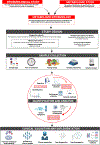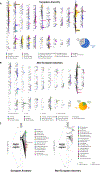Metabolomic epidemiology offers insights into disease aetiology
- PMID: 37872285
- PMCID: PMC11164316
- DOI: 10.1038/s42255-023-00903-x
Metabolomic epidemiology offers insights into disease aetiology
Erratum in
-
Author Correction: Metabolomic epidemiology offers insights into disease aetiology.Nat Metab. 2024 Jan;6(1):187. doi: 10.1038/s42255-023-00967-9. Nat Metab. 2024. PMID: 38191668 No abstract available.
Abstract
Metabolomic epidemiology is the high-throughput study of the relationship between metabolites and health-related traits. This emerging and rapidly growing field has improved our understanding of disease aetiology and contributed to advances in precision medicine. As the field continues to develop, metabolomic epidemiology could lead to the discovery of diagnostic biomarkers predictive of disease risk, aiding in earlier disease detection and better prognosis. In this Review, we discuss key advances facilitated by the field of metabolomic epidemiology for a range of conditions, including cardiometabolic diseases, cancer, Alzheimer's disease and COVID-19, with a focus on potential clinical utility. Core principles in metabolomic epidemiology, including study design, causal inference methods and multi-omic integration, are briefly discussed. Future directions required for clinical translation of metabolomic epidemiology findings are summarized, emphasizing public health implications. Further work is needed to establish which metabolites reproducibly improve clinical risk prediction in diverse populations and are causally related to disease progression.
© 2023. Springer Nature Limited.
Conflict of interest statement
Competing interests
The authors declare no competing financial interests.
Figures




References
-
- Oliver SG, Winson MK, Kell DB & Baganz F Systematic functional analysis of the yeast genome. Trends Biotechnol. 16, 373–378 (1998). - PubMed
Publication types
MeSH terms
Grants and funding
LinkOut - more resources
Full Text Sources
Research Materials

